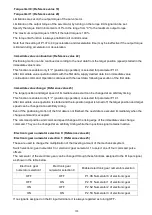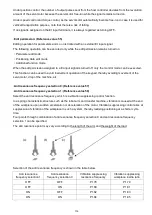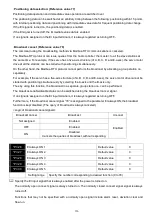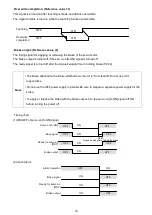
129
·Command Pulse inhibit: (Reference value 26)
The pulse input in the position control mode is enabled or disabled.
The command pulse is not accepted while the command pulse inhibit signal remains turned on.
If no signal is assigned on the EI input terminals, it is always regarded as turning OFF.
。
Therefore, in this case, only when the servo-ON [S-ON] is turned ON, the pulse input will be always enabled.
·Command pulse ratio 1: (Reference value 27)
·Command pulse ratio 2: (Reference value 28)
Use the parameters to change the multiplication of the command input pulse under position control in the
extension mode.
These functions are enabled only if "6" (extension mode) or "7" (positioning operation) is selected for
parameter P1.01.
To perform p
ulse operation in the extension mode (mode compatible with conventional α Series),be sure to
assign command pulse ratio 1 or command pulse ratio 2 to a CONT input signal.
Turn servo-on, position control and command pulse ratio 1 (2) on to enable pulse operation.
If command pulse ratio 1 is turned on, the ratio set at P2.54 (command pulse ratio 1) is enabled.
If command pulse ratio 2 is turned on, the ratio set at P2.55 (command pulse ratio 2) is enabled.
If no signal is assigned on the EI input terminals, it is always regarded as turning OFF.
。
·Proportional control: (Reference value 29)
Proportional band control is adopted as a servo motor drive control method.
With S-ON signal turned on, the signal will be turned on while the servo motor shaft is mechanically locked.
If the proportional control is turned on during servo motor rotation, position control becomes unstable.
If the brake is applied under position control with the servo locked, an overload (oL) alarm is detected.
Be sure to turn off P motion before applying the brake from an external unit.
If no signal is assigned on the EI input terminals, it is always regarded as turning OFF.
。
·Pause: (Reference value 31)
This signal temporarily stops the start positioning, homing motion and interrupt positioning motion.
Deceleration starts at the rising edge of the pause signal (31). While the signal is turned on, the start
positioning, homing and interrupt positioning motions are interrupted and stopped. After the signal is turned off,
the remaining motion continues.
The signal is ineffective to pulse ratio 1, pulse ratio 2, and manual forward and reverse rotation.
Deceleration follows the designated acceleration/deceleration time, different from forced stop (10).
The pause is enabled to the current positioning motion.
If no signal is assigned on the EI input terminals, it is always regarded as turning OFF.
。






























